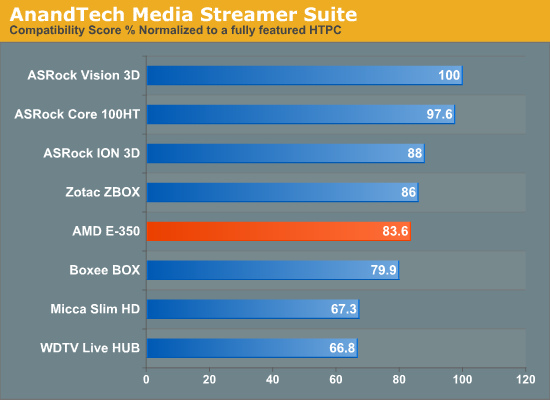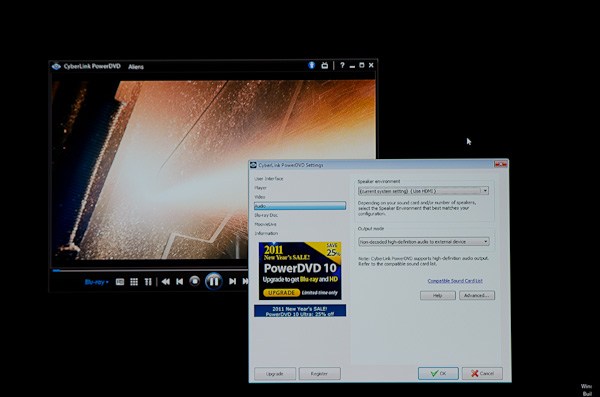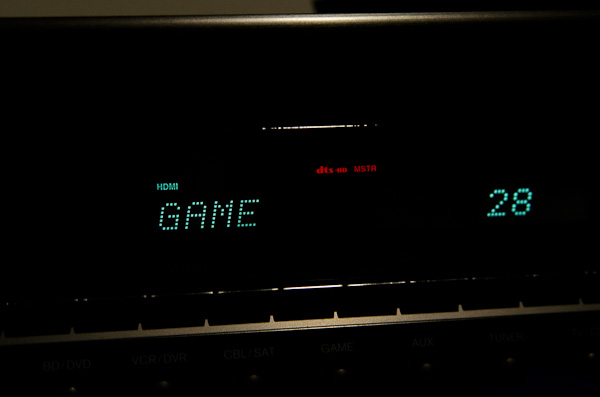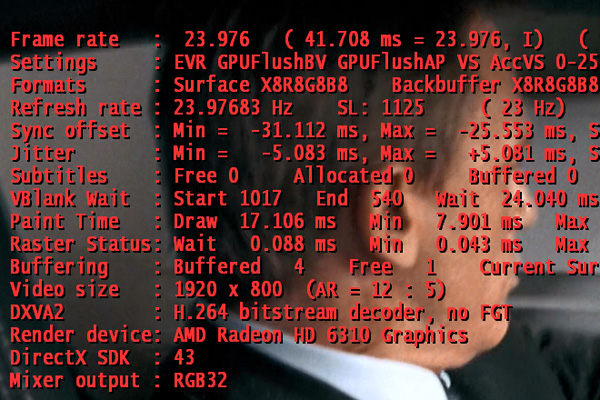The Brazos Review: AMD's E-350 Supplants ION for mini-ITX
by Anand Lal Shimpi on January 27, 2011 6:08 PM ESTVideo Decode Capabilities: Is Brazos the New ION?
While Atom may have been the right product at the right time, it was a very conservative architecture paired with a very conservative platform. For netbooks and nettops Intel chose to assume no risk at all, pairing Atom with the proven 945 chipset. As a result, it left a lot of room for innovation - something NVIDIA saw and capitalized on with ION.
While VIA created the mini-ITX form factor, it was really NVIDIA that made it interesting. The first mini-ITX ION platforms gave you almost everything you needed to build a fully capable HTPC. For video playback, with NVIDIA’s GPU (or at least its fixed function decode pipeline) doing the heavy lifting, the fact that you had an anemic Atom a couple centimeters away didn’t matter. The problem with ION is that it had no future. Without a DMI license, NVIDIA would not be able to build future versions of ION for Atom’s successors. Even after the settlement it’s unlikely we will ever see modern versions of ION, especially considering that Intel’s 2011 Atom platform (Cedar Trail) will finally integrate H.264 decode acceleration in Q4.
Where Intel is conservative, AMD will innovate. Brazos adds a number of advantages from a media standpoint over Atom. There’s native HDMI support and a full implementation of AMD’s UVD3 decode engine supporting hardware H.264, VC-1 and MPEG-2 acceleration. Although both of these advantages are also enjoyed by ION the next feature isn’t. Brazos supports Dolby TrueHD and DTS-HD MA bitstreaming over HDMI. From a feature standpoint, Brazos is even more complete than ION.
I ran MSI’s Brazos board through our Media Streaming compatibility suite. Below is Brazos’ compatibility score compared to the other devices and HTPCs we’ve put through the suite:

Failed Tests
- 1080p60 60 fps L5.1 H.264
- L5.1 H.264 (16 reference frames)
- FLAC, ASS Subs - High CPU Utilization
- HD Real Media
- Deinterlacing
Numerically, Brazos actually falls behind ION. Allow me to explain why. Our Media Streaming suite tests virtually everything you might throw at a HTPC. When it comes to the most commonly found content, Brazos excels. It can handle Blu-ray discs (although there’s no Blu-ray 3D support), it can deal with 1080p x264s commonly found online and it even accelerates Flash video (more on this later). Brazos’ UVD3 however is tied to clock speed, and the GPU clock of the Radeon HD 6310 is pretty low at 500MHz. As a result, Brazos fails certain tests. The platform is incapable of accelerating and playing back 1080p60 H.264 video. Very little content falls into this category, however if you want to play it you can’t on Brazos. The good news is 1080i60 works just fine.
Brazos’ GPU also fails all of our deinterlacing tests, something we noticed in reviews of AMD’s entry level GPUs. The higher end models don’t have an issue here but the lesser equipped models do. Again, chances are that you won’t want to watch interlaced content on your Brazos HTPC so this is likely not a big issue.
The other shortcomings are videos with components that aren’t accelerated by UVD3. For example, HD Real Video chugs on Brazos as does our heavy FLAC + ASS subs test. If you’re playing non-3D Blu-ray content or 1080p24 x264s you find on the web, Brazos will easily fit the bill. It’s the more eccentric content that you’ll run into CPU limitations with.
Since the Radeon HD 6310 is derived from AMD’s desktop GPUs we get full 23.976 fps support when you select 23Hz in AMD’s Catalyst driver:
Selecting 24Hz yields a 24.000Hz refresh rate.
As I mentioned earlier bitstreaming both TrueHD and DTS-HD MA are supported over HDMI:














176 Comments
View All Comments
Matt310 - Friday, January 28, 2011 - link
At home in my desktop machine I have a 4-lane PCI-x hardware RAID card with four 1.5TB drives configured in RAID 5 for speed hand fault tolerance. For a while now I've been wondering how the i/o performance of a good RAID card would fair if it was moved to a low-power (e.g. Atom- or Brazos-based) mini-ITX NAS system. I've been googling for a review of this setup but not been able to find anything conclusive.Think a lot of people would appreciate if you guys could give this a try and report on your findings!
Thanks Anand!
msroadkill612 - Friday, February 4, 2011 - link
Well you should know - dont the raid cards have their own smarts & put little work on the cpu?My guess is it would be a great unit for a dedicated server. In the old days, many dedicated servers kept their 486 pcS for a decade as they ran fine.
a post above linked to a comparison of running pciE graphics cards at 1,4,8,16 lanes, & the difference between 4 x &16 by was slight. I imagine its the same with raid cards.
jjcrandall - Friday, January 28, 2011 - link
Anand, I didn't see what hdd you used for the tests. It would be very interesting to see how this platform performed in some of the benchmarks with a ssd. I know pcmark & vantage productivity benches use hdd test's to a certain degree.This really shows either how poor netburst was as an architecture, or how good existing sub 10w designs are.
Shadowmaster625 - Friday, January 28, 2011 - link
It seems like the E-350 was built for overclocking. Especially on the desktop or with any cooling solution that has an extra 10 Watts of thermal headroom. Sooner or later someone is going to release a mini-ITX board that can OC an E-350 up to 2.5GHz and beyond. Right? It's not like the new intel cpu where you cannot overclock it, right?bjacobson - Saturday, January 29, 2011 - link
yeah I definitely want to overclock it!In a laptop when you've got an 8-10 hour battery life, if you know you're only going to need the laptop for 4 hours today, why not just crank up the speed? Great having that option.
Arnulf - Friday, January 28, 2011 - link
"Unfortunately in modern titles that's not always enough to have a playable experience, but with older games you should be able to do more with Brazos than you ever could with Atom or even ION for that matter. The CPU/GPU balance in the E-350 is good enough that I feel like Llano could make for a pretty decent value gaming machine."Given that Zacate/Brazos performs at the level of 5+ years old midrange desktop CPU with midrange GPU and considering the quoted statement above it would be very interesting to see some actual performance data taken in titles that Zacate/Brazos *can* run at bearable FPS rates.
You could look up your performance charts from 5 years ago, dig out the old titles and rerun the benchmarks with those titles on Zacate/Brazos. This should give people better idea what they can expect from this generation of APUs. Sub-20 FPS rates in modern titles at rather low resolution and with all details at minimum isn't exactly what people have their sights on when deciding whether to shell out money for their new toy. Comparison with other crappy graphics that is on par with 5 year old solutions may give AMD's platform some edge over competition from Intel's camp, but it utterly meaningless as nobody is planning to use it in such setting.
Myself, I'd *love* to see some factual data from titles such as CoD2, DiRT, Doom3, etc. - the games you were referring to in the paragraph quoted above and all of which you already have reference benchmarks of (in order to have something to compare Zacate/Brazos against, without having t rerun all the benchmarks with old software titles). Such a benchmark with usable performance and enough eye candy will help put Zacate/Brazos' use in gaming setting into perspective, very much unlike those ~20 FPS tests you did above.
These merely indicate that integrated graphics of today are still useless for gaming.
bjacobson - Saturday, January 29, 2011 - link
Hm that's a good point. Likely I'd be playing a copy of UT2k4, perhaps quake 3 online, or some older online RTS. How do these fare at those games?cjs150 - Friday, January 28, 2011 - link
Nice review.There is a passively cooled E-350 board coming out. The review convinces me that this will be the right choice for the HTPC for the main room.
Why: TV already connected to an AV receiver so an E-350 system can use the HDMI connection to the AV receiver. E350 more than powerful for BluRay, fine for some light web surfing, ripping music. Maybe stick a TV tuner in as well and that is the main room sorted.
I have no intention of playing modern games on it so lack of power is not a problem. I have a bigger PC in study to rip movies if it takes too long on the E350.
But I also have an Atom based system. Again passively cooled. I use it as a server for the home network. It works just fine. It was cheap, ultra easy to build and just works. The fact that Atom is rubbish does not matter because as long as it can shift data round the network I need nothing more.
So every CPU has a purpose, just with some we have to look hard
BernardP - Friday, January 28, 2011 - link
AMD might score technical successes with its new lineup (Bobcat, llano, Bulldozer), but it will have trouble marketing them if only meaningless C Series, E Series, A series (Llano) and whatever Series (Bulldozer) are used.last time I looked, a C350 and E350 were Mercedes-Benz models, while CSeries is an upcoming Bombardier jet:
http://en.wikipedia.org/wiki/Bombardier_CSeries
In addition the numbers seem meaningless. Even intel's Core naming scheme is clearer than AMD's.
AMD simply needs 3 distinct marketing names that the general public will understand for its 3 new product lines code names: Bobcat - Llano - Bulldozer. "Fusion" and "Vision" just don't cut it anymore, as they have already been used for years by AMD.
One can easily see that there is a problem is the naming scheme when OEMs have to use the Zacate and Brazos code names to try to describe the product, like this example:
http://www.asus.com/product.aspx?P_ID=9BmKhMwWCwqy...
nitrousoxide - Friday, January 28, 2011 - link
Yeah...the naming scheme ASUS and ACER use makes people mad when choosing laptops :)